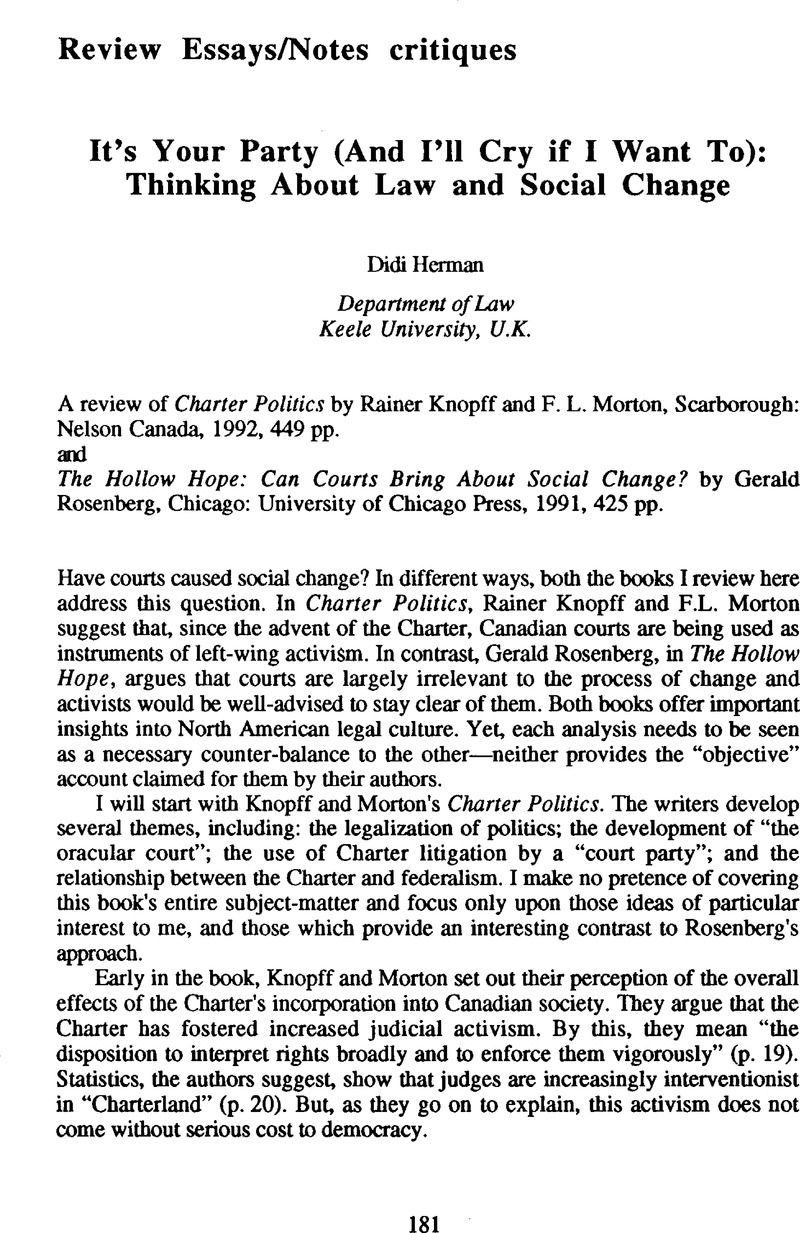No CrossRef data available.
Published online by Cambridge University Press: 18 July 2014

1. Singh et al. v. Minister of Employment [1985] 1 S.C.R. 177.
2. See, for example, Cairns, A. C., “The Fragmentation of Canadian Citizenship” in Kaplan, W., ed., Belonging: The Meaning and Future of Canadian Citizenship (Montreal & Kingston: McGill-Queen's University Press, 1993) 181;Google ScholarCairns, A. & Williams, C., eds., Constitutionalism, Citizenship and Society in Canada (Toronto: University of Toronto Press, 1985)Google Scholar.
3. Knopff and Morton acknowledge that there is another “left” position at odds with this view - a different set of leftist intellectuals, epitomized in the pages of Charter Politics by Michael Mandel. They describe his book, The Charter of Rights and the Legalization of Politics in Canada (Toronto: Wall and Thompson, 1989)Google Scholar, as this movement's “manifesto.” The authors set out Mandel's argument at some length, but it is not clear why, as they do not engage with the ideas despite the ways in which Mandel's perspective undermines their own (by suggesting that “leftist activists” will not progress social transformation through Charter litigation).
4. One example of what I mean can be found in Chapter Six. For several pages, it is not clear whether Knopff and Morton are reciting the views of others or setting out their own understandings (see pp. 139–42). The authors shift between so many perspectives while at the same time being intent on getting there own point of view across. These passages do not work because, in short, they are incoherent (see also pp. 161–67).
5. See, for example, Knopff, R., Human Rights and Social Technology: The New War On Discrimination (Ottawa: Carleton University Press, 1989);Google ScholarKnopff, R., “The Statistical Protection of Minorities: Affirmative Action Policy in Canada” in Nevitte, N. & Kornberg, A., eds., Minorities and the Canadian State (Oakville: Mosaic Press, 1985) 87Google Scholar.
6. Knopff, ibid. at 19.
7. Morton, F. L., Morgentaler v. Borowski: Abortion, the Charter and the Courts (Toronto: McLelland & Stewart, 1992) at 320Google Scholar.
8. See c. 4 and 6 in Herman, D., Rights of Passage: Struggles For Lesbian and Gay Legal Equality (Toronto: University of Toronto Press, 1994)Google Scholar.
9. “Significant social reform” is defined by Rosenberg as meaning “policy change with nationwide impact” (p. 4).
10. Brown v. Board of Education, 347 U.S. 483 (1954) (Brown I); 349 U.S. 294 (1955) (Brown II) (U.S.S.C).